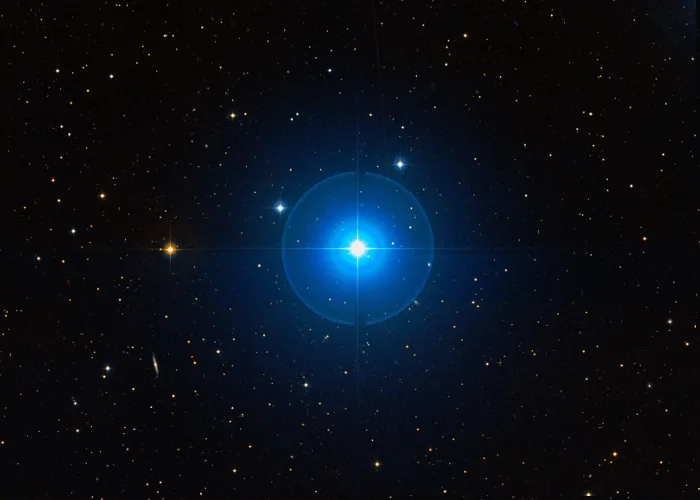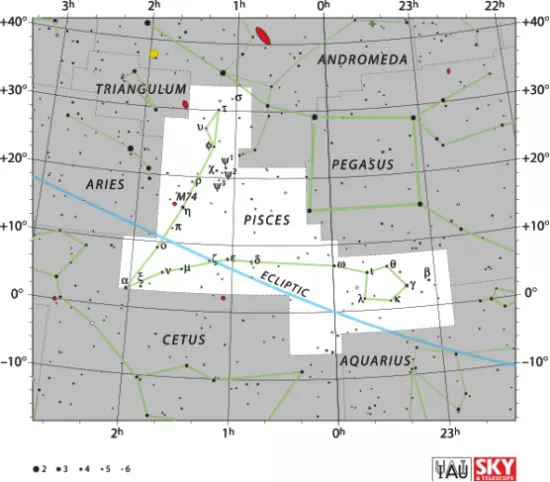Alrescha, Alpha Piscium (α Psc), is a binary star system located approximately 151 light years away in the constellation Pisces. With a combined apparent magnitude of 3.82, it is the third brightest point of light in Pisces, after Alpherg and Gamma Piscium. Individually, the brighter component is the eighth brightest star in the constellation.
Star system
Alpha Piscium is a close binary star composed of two chemically peculiar stars of the spectral types kA0hA7 Sr and kA2hF2mF2 (IV). The primary component, Alpha Piscium A, has an apparent magnitude of 4.33 and the secondary, Alpha Piscium B, shines at magnitude 5.23. The components are sometimes given the spectral types A0p and A3m, indicating white main sequence stars. They may themselves be spectroscopic binary systems.
Alpha Piscium A and B have an orbital period of 3,267.4 years. The system has a semi-major axis of 7.4 arcseconds. The two stars are currently separated by only 1.8 arcseconds and will make their closest approach around the year 2060.
Alpha Piscium A (formally known as Alrescha) has 2.55 times the Sun’s mass and a radius 2.45 times that of the Sun. With an effective temperature of around 10,233 K, it is 55 times more luminous than the Sun. The star is a fast spinner, with a projected rotational velocity of 81 km/s. It shows an abundance of silicon, strontium and chromium in its spectrum.

Alrescha (Alpha Piscium), image credit: ESO/Digitized Sky Survey 2 (CC BY 4.0)
The companion, Alpha Piscium B, has a mass of 2.64 solar masses and a radius of 2.66 solar radii. With a surface temperature of around 10,000 K, it has an energy output of 63 solar luminosities. It spins at 84 km/s and has an estimated age of 331 million years.
Alrescha is classified as an Alpha2 Canum Venaticorum variable. Its brightness varies by only a hundredth of a magnitude with a period of 0.845 days, corresponding to the star’s rotation period. Astronomers have also identified a 6.65-day variation period.
Named after the class prototype Cor Caroli (α2 Canum Venaticorum) in the constellation Canes Venatici, α2 CVn variables are strongly magnetic, chemically peculiar stars whose brightness varies either because their magnetic fields cause chemical spots across their surfaces or, as the more recent studies suggest, because of magnetospheric clouds above their surfaces. The nonuniform distribution of various elements, combined with rotation, causes the stars’ light to vary by 0.01 to 0.1 magnitudes with periods of 0.5 to 160 days.
Other stars in this class include Alioth (Epsilon Ursae Majoris) in the constellation Ursa Major, Nashira (Gamma Capricorni) in Capricornus, Mahasim (Theta Aurigae) in Auriga, Mesarthim (Gamma Arietis) in Aries, Alpha Doradus in Dorado, and Beta Hydrae in Hydra.
Name
The name Alrescha (pronunciation: /ælˈriːʃə/) comes from the Arabic ar-Rishā’ or al-risha’, meaning “the cord.” It was historically also spelled Alrischa, Alrisha, Al Rescha, and Alresha. This was the name of an old Arabic lunar mansion that included Mirach (Beta Andromedae). It was erroneously transferred to Alpha Piscium in more modern times.
The cord may have also been a remnant of an asterism joining the two fish in the ancient Babylonian zodiac. The Babylonian name was Riksu (“cord). In ancient Arabic astronomy, the stars of the cord were known as al-hut, “the Fish,” and corresponded to the constellation Pisces. Mirach, the brightest star in the ancient Fish, was called batn al-hut, meaning “the Fish’s Belly.”
The International Astronomical Union’s (IAU) Working Group on Star Names (WGSN) approved the name Alrescha on August 21, 2016. The name formally applies only to the primary component in the system, Alpha Piscium A.
Alpha Piscium was also traditionally called Kaitain and Okdah. Okdah (or Okda) is derived from the Arabic ʽuqdah, meaning “the knot.” The names come from Ptolemy’s designation Σύνδεσμος τῶν Ἰχθύων (τῶν Λίνων), meaning “the knot of the Fishes,” which was later translated into Arabic as Uḳd al Ḣaiṭain.
In traditional Chinese astronomy, Alrescha was known as 外屏七 (Wài Píng qī), the Seventh Star of Outer Fence (Outer Screen). It formed the Outer Fence asterism with Delta Piscium, Epsilon Piscium, Revati (Zeta Piscium), Mu Piscium, Nu Piscium, and Xi Piscium. The asterism represented a fence to screen off the Celestial Pigsty. It was part of the larger Legs mansion, which represented the tail of the White Tiger.
Location
Alrescha lies in the southeastern corner of Pisces, near the border with Cetus. It is the star that connects the two lines of faint stars that represent the cords that connect the two fish of Pisces.
Alpha Piscium appears roughly halfway between Diphda, the brightest star in Cetus, and the bright Pleiades cluster in Taurus. It appears close to the imaginary line extended from Almach in Andromeda through Hamal in Aries. The star lies in the same region as the Head of Cetus, a faint semi-circular asterism that can be found using the V-shaped Hyades as a pointer.
The faint spiral galaxies IC 194 and IC 197 appear in the same field of view as Alrescha.

Alrescha location, image: Stellarium

Alrescha, IC 194 and IC 197, image credit: ESO/Digitized Sky Survey 2 (CC BY 4.0)
Constellation
Alrescha is located in the zodiac constellation of Pisces (the Fishes). Pisces is one of the Greek constellations, catalogued by the Greco-Roman astronomer Claudius Ptolemy of Alexandria in his Almagest in the 2nd century CE. It is one of the 12 zodiac constellations, located on the ecliptic (the Sun’s apparent path across the sky). Pisces is also one of the 15 equatorial constellations. Lying on the celestial equator, these constellations are visible from any place on Earth for at least part of the year.
Pisces is the 14th largest constellation in the sky and the fourth largest zodiac constellation, after Virgo, Aquarius and Leo. It stretches across 889 square degrees of the predominantly northern sky. However, without any stars brighter than magnitude 3.0, the constellation does not stand out in the sky next to the brighter Pegasus and Andromeda.
Alpherg (Eta Piscium), the brightest star in Pisces, is a variable yellow giant with an apparent visual magnitude of 3.611, located approximately 350 light-years away.
Other relatively bright stars in Pisces include the yellow giant Gamma Piscium, the yellow-white main sequence stars Omega Piscium and Iota Piscium, the orange giants Torcular (Omicron Piscium), Epsilon Piscium, Theta Piscium, Delta Piscium and Nu Piscium, the variable red giant 30 Piscium (YY Psc), and the hot blue main sequence star Fumalsamakah (Beta Piscium), which marks the mouth of the western fish.
Pisces is also home to the variable red giant and carbon star TX Piscium (19 Psc), the multiple star system Zeta Piscium (Revati), the orange dwarf HD 3167 (K2-96) with four orbiting extrasolar planets, and Van Maanen’s Star (Van Maanen 2), the nearest known solitary white dwarf to the Sun, located 14.072 ly away.
Notable deep sky objects in Pisces include the bright spiral galaxy Messier 74 (the Phantom Galaxy), the interacting spiral galaxies NGC 520 (the Flying Ghost Galaxy), the merging galaxies NGC 7714 and NGC 7715, the interacting pair NGC 470 and NGC 474, the spiral galaxies NGC 105, NGC 488 and NGC 266, the lenticular galaxies NGC 128 and NGC 524, the galaxy cluster CL 0024+1654, the double radio galaxy NGC 383 and the Pisces Chain of galaxies (Pisces Cloud, Arp 331), the Pisces Dwarf (Pisces I), the collisional ring galaxy popularly known as the Bullseye Galaxy (LEDA 1313424), the polar-ring galaxy NGC 660, the dumbbell galaxy NGC 326, and the active galaxy 3C 31.

Pisces constellation map, image credit: IAU and Sky & Telescope magazine (Roger Sinnott & Rick Fienberg) (CC BY 3.0)
The best time of the year to observe the stars and deep sky objects in Pisces is during the month of November, when the constellation climbs higher above the horizon in the evening. The entire constellation is visible from locations north of the latitude 65° S.
The 10 brightest stars in Pisces are Alpherg (Eta Psc, mag. 3.611), Gamma Piscium (mag. 3.699), Alrescha (Alpha Psc, mag. 3.82), Omega Piscium (mag. 4.01), Iota Piscium (mag. 4.13), Torcular (Omicron Psc, mag. 4.27), Epsilon Piscium (mag. 4.27), Theta Piscium (mag. 4.27), 30 Piscium (mag. 4.31 – 4.41), and Fumalsamakah (Beta Psc, mag. 4.40).
Alrescha – Alpha Piscium
| Spectral class | kA0hA7 Sr + kA2hF2mF2 (IV) |
| Variable type | Alpha2 Canum Venaticorum |
| Apparent magnitude | 3.82 (4.33 + 5.23) |
| Absolute magnitude | +0.50 |
| Distance | 151 ± 7 light years (46 ± 2 parsecs) |
| Parallax | 21.66 ± 1.06 mas |
| Radial velocity | 7.50 ± 1.8 km/s |
| Proper motion | RA: +32.45 ± 1.01 mas/yr |
| Dec.: +0.04 ± 0.72 mas/yr | |
| Constellation | Pisces |
| Right ascension | 02h 02m 02.81972s |
| Declination | +02° 45′ 49.5410″ |
| Names and designations | Alrescha, Alrischa, Okdah, Okda, Kaitain, Syndesmos, Alpha Piscium, 113 Piscium, 113 Psc, HIP 9487, SAO 110291, FK5 28, JP11 577, BD+02°317, AKARI-IRC-V1 J0202028+024549, CSI+02 317 3, GEN# +1.00012447, NSV 705, PMSC 01569+0217, TD1 1179, TIC 422692360, IRAS 01594+0231, IRAS F01594+0231, 2MASS J02020277+0245495, STF 202, UBV 2056, UBV M 8620, uvby98 100012447, AAVSO 0156+02, WISE J020202.81+024549.5, WISEA J020202.80+024549.7, ADS 1615 AB, CCDM J02020+0246AB, IDS 01569+0217 AB, IDS 02020+0246 AB, WDS J02020+0246AB |
Alpha Piscium A
| Mass | 2.55 ± 0.11 M☉ |
| Luminosity | 55 L☉ (44 – 69 L☉) |
| Radius | 2.45 R☉ |
| Temperature | 10,233 K (9,750 – 10,740 K) |
| Rotational velocity | 81 km/s |
| Surface gravity | 3.85 cgs |
| Names and designations | Alrescha, Alpha Piscium A, Alpha Psc A, α Piscium A, α Psc B, 113 Piscium A, 113 Psc A, HD 12447, HR 596, BD+02 317A, AG+02 204, GC 2452, GCRV 1119, PLX 420.00, PPM 145227, CSI+02 317 1, SKY# 2983, Renson 3180, PMSC 01569+0217A, N30 421, ROT 285, WEB 1988, YPAC 285, TYC 40-1338-1, Gaia DR2 2517584007848935808, Gaia DR3 2517584007848935808, ADS 1615 A, CCDM J02020+0246A, WDS J02020+0246A |
Alpha Piscium B
| Mass | 2.64 M☉ (2.36 – 2.85 M☉) |
| Luminosity | 63 L☉ (52 – 76 L☉) |
| Radius | 2.66 ± 0.45 R☉ |
| Temperature | 10,000 ± 710 K |
| Age | 331 million years (178 – 490 Myr) |
| Rotational velocity | 84 km/s |
| Surface gravity | 4.01 ± 0.14 cgs |
| Names and designations | Alpha Piscium B, Alpha Psc B, α Piscium B, α Psc B, 113 Piscium B, 113 Psc B, HD 12446, HR 595, BD+02 317B, GCRV 1120, CSI+02 317 2, CSV 100159, PMSC 01569+0217B, PMSC 01569+0217Bab, Renson 3170, TYC 40-1338-2, Gaia DR2 2517584003554093696, WEB 1992, ADS 1615 B, CCDM J02020+0246B, WDS J02020+0246B |